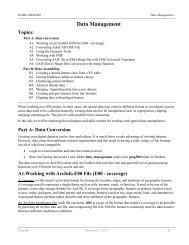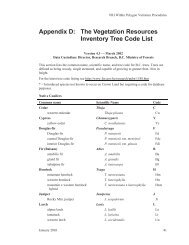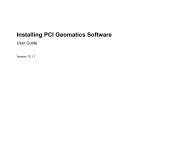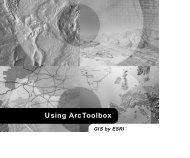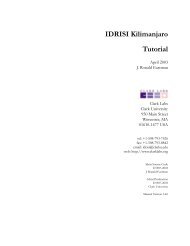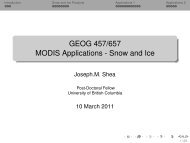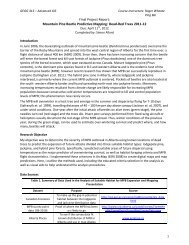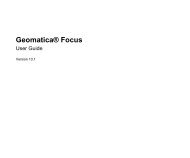Understanding Map Projections
Understanding Map Projections
Understanding Map Projections
Create successful ePaper yourself
Turn your PDF publications into a flip-book with our unique Google optimized e-Paper software.
LIST OF SUPPORTED MAP PROJECTIONS<br />
Aitoff<br />
Alaska Grid<br />
Alaska Series E<br />
Albers Equal Area Conic<br />
Azimuthal Equidistant<br />
Behrmann Equal Area Cylindrical<br />
Bipolar Oblique Conformal Conic<br />
Bonne<br />
Cassini–Soldner<br />
Chamberlin Trimetric<br />
Craster Parabolic<br />
Cylindrical Equal Area<br />
Double Stereographic<br />
Eckert I<br />
Eckert II<br />
Eckert III<br />
Eckert IV<br />
Eckert V<br />
Eckert VI<br />
A compromise projection developed in 1889 and used for world<br />
maps.<br />
This projection was developed to provide a conformal map of Alaska<br />
with less scale distortion than other conformal projections.<br />
Developed in 1972 by the United States Geological Survey (USGS) to<br />
publish a map of Alaska at 1:2,500,000 scale.<br />
This conic projection uses two standard parallels to reduce some of<br />
the distortion of a projection with one standard parallel. Shape and<br />
linear scale distortion are minimized between the standard parallels.<br />
The most significant characteristic of this projection is that both<br />
distance and direction are accurate from the central point.<br />
This projection is an equal-area cylindrical projection suitable for<br />
world mapping.<br />
This projection was developed specifically for mapping North and<br />
South America and maintains conformality.<br />
This equal-area projection has true scale along the central meridian<br />
and all parallels.<br />
This transverse cylindrical projection maintains scale along the<br />
central meridian and all lines parallel to it. This projection is neither<br />
equal area nor conformal.<br />
This projection was developed and used by the National Geographic<br />
Society for continental mapping. The distance from three input<br />
points to any other point is approximately correct.<br />
This pseudocylindrical equal-area projection is primarily used for<br />
thematic maps of the world.<br />
Lambert first described this equal-area projection in 1772. It is used<br />
infrequently.<br />
This azimuthal projection is conformal.<br />
This pseudocylindrical projection is used primarily as a novelty map.<br />
A pseudocylindrical equal-area projection.<br />
This pseudocylindrical projection is used primarily for world maps.<br />
This equal-area projection is used primarily for world maps.<br />
This pseudocylindrical projection is used primarily for world maps.<br />
This equal-area projection is used primarily for world maps.<br />
30 • <strong>Understanding</strong> <strong>Map</strong> <strong>Projections</strong>




